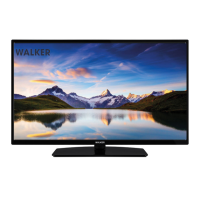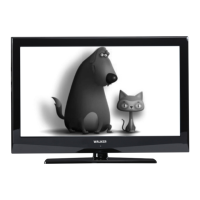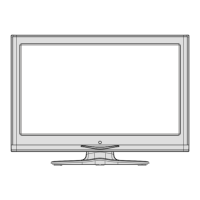Do you have a question about the Walker WPS32DVD and is the answer not in the manual?
Place the device on a solid even surface. For ventilation, leave a free space...
This device is used to receive and display TV programmmes, as well as to play CDs and DVDs.
This section illustrates how to view the TV.
Controls for operating DVD playback functions such as Play, Pause, and Stop.
Explains how to set and use the custom function for My Button 1.
Explains how to set and use the custom function for My Button 2.
Instructions on how to turn the TV on from standby mode.
Instructions on how to turn the TV off or to standby mode.
Guidance for connecting the TV to a cable network.
Guidance for connecting the TV to an aerial.
Guidance for connecting the TV to a satellite dish.
Sets the picture mode for viewing requirements.
Sets the lightness and darkness values of the screen.
Sets the brightness value for the screen.
Sets the sharpness value for the objects displayed on the screen.
Sets the colour value, adjusting the colors.
Sets Power Save Mode as Eco, Picture Off and Disabled.
Controls the backlight level and can be set to Auto, Maximum, Minimum and Eco Mode.
Reduces noise amount for weak or noisy broadcast signals.
Changes contrast rate by using dynamic contrast function.
Sets the desired colour tone.
Sets the picture size to Auto, 16:9, Subtitle, 14:9, 4:3 or Cinema.
Enhances blackness in the picture when watching from HDMI source.
Turns on feature for clear fast motion scenes in films.
Adjusts the desired skin tone.
Adjusts the desired colour tone.
Configures colour temperature values using the RGB Gain feature.
Resets the picture settings to factory default settings.
Automatically optimizes the display.
Shifts image horizontally to right or left side of the screen.
Shifts image vertically towards the top or bottom of the screen.
Corrects interference like vertical banding in dot intensive presentations.
Improves picture clarity by trial and error method.
Adjusts volume level.
Allows preset selection for sound equalization.
Used for emphasizing left or right speaker balance.
Sets headphone volume.
Selects Mono, Stereo, Dual I or Dual II audio modes.
Sets sound to obtain fixed output level between programmes.
Sets headphone jack as Lineout or Headphone.
Enables or disables the Dynamic Bass.
Changes surround sound mode to On or Off.
Sets digital out audio type.
Displays automatic tuning options for different broadcast types.
Feature for direct broadcast entry.
Searches for the linked channels in the broadcast system.
Fine tunes analogue channels.
Resets TV to factory settings and starts first time installation.
Clears stored channels and settings.
Controls conditional access modules when available.
Configures language settings.
Configures parental settings.
Sets timers for selected programmes.
Displays recording configuration menu.
Sets date and time.
Enables or disables selected source options.
Displays satellite settings.
Displays network settings.
Changes timeout duration for menu screens.
Locates encrypted channels during search.
Activates or deactivates blue background system.
Ensures TV has the most update information.
Displays application version.
Enables special signal concerning audio for hearing impaired.
Provides narration track for blind and visually impaired viewers.
Sets the timeout value of auto off feature.
Searches for available broadcasts when TV is in standby.
Activates mode for displaying TV in a store.
Allows sharing files stored on your smartphone with the TV.
Configures the power up mode preference.
Enters BISS key for satellite signal scrambling system.
Enables or disables the virtual remote feature.
Accesses event options menu for selected programme.
Switches to the selected channel within EPG.
Sets or cancels programme recording timers.
Steps for connecting the TV to a wired LAN network.
Settings for wired and wireless connection options.
Settings for connecting the TV via ETHERNET INPUT.
Steps for using the Veezy 200 Wireless USB dongle.
Troubleshooting steps for when the wireless network is not available.
Information on improving slow network connection speed.
Troubleshooting steps for playback disruptions or slow reactions.
Instructions for handling and caring for DVD discs.
Instructions for cleaning DVD discs.
Lists features supported by the DVD player.
Steps on how to insert a disc and start playback.
Common issues and notes related to DVD playback.
Configures various settings for DVD playback.
Configures video settings for DVD playback.
Sets language preferences for DVD menus and audio.
Selects the default OSD language of player menus.
Selects the default audio language for DVD playback.
Selects the DVD's disc menu language.
Selects the default subtitle language if supported by the DVD disc.
Details DVD mode preferences including Default, Downmix, Surround, Stereo, Parental.
Allows changing the current password for parental control.
Configures Spdif Output for PCM or RAW audio.
Details button combinations for playback control.
Activates teletext mode or mixes teletext with programme.
Selects the teletext index page.
Shows hidden information (e.g. solutions of games).
Holds a text page when convenient or resumes.
Selects subcode pages if available when teletext is activated.
Press to select a teletext page.
Operates digital teletext information using coloured buttons.
Manually checks for new software upgrades.
Searches for and downloads critical software upgrades in background.
TV wakes up at 03:00 to search for new software upgrades.
Notes on image persistence and ghosting on LED TVs.
Troubleshooting steps for when the TV has no power.
Troubleshooting tips for poor picture quality.
Troubleshooting steps when there is no picture.
Troubleshooting steps for when there is no sound.
Troubleshooting steps when the remote control does not operate.
Troubleshooting steps for input source selection issues.
Troubleshooting steps when recording is unavailable.
Troubleshooting steps for 'USB is too slow' message.
Troubleshooting for internet connection and DLNA issues.
Troubleshooting steps for invalid domain issues in DLNA mode.
Troubleshooting steps for poor DVD picture quality.
Troubleshooting steps for when a disc does not play.
Troubleshooting steps for incorrect OSD language.
Details about TV broadcasting standards supported.
Details about digital reception standards supported.
Details about VHF and UHF channels supported.
Place the device on a solid even surface. For ventilation, leave a free space...
This device is used to receive and display TV programmmes, as well as to play CDs and DVDs.
This section illustrates how to view the TV.
Controls for operating DVD playback functions such as Play, Pause, and Stop.
Explains how to set and use the custom function for My Button 1.
Explains how to set and use the custom function for My Button 2.
Instructions on how to turn the TV on from standby mode.
Instructions on how to turn the TV off or to standby mode.
Guidance for connecting the TV to a cable network.
Guidance for connecting the TV to an aerial.
Guidance for connecting the TV to a satellite dish.
Sets the picture mode for viewing requirements.
Sets the lightness and darkness values of the screen.
Sets the brightness value for the screen.
Sets the sharpness value for the objects displayed on the screen.
Sets the colour value, adjusting the colors.
Sets Power Save Mode as Eco, Picture Off and Disabled.
Controls the backlight level and can be set to Auto, Maximum, Minimum and Eco Mode.
Reduces noise amount for weak or noisy broadcast signals.
Changes contrast rate by using dynamic contrast function.
Sets the desired colour tone.
Sets the picture size to Auto, 16:9, Subtitle, 14:9, 4:3 or Cinema.
Enhances blackness in the picture when watching from HDMI source.
Turns on feature for clear fast motion scenes in films.
Adjusts the desired skin tone.
Adjusts the desired colour tone.
Configures colour temperature values using the RGB Gain feature.
Resets the picture settings to factory default settings.
Automatically optimizes the display.
Shifts image horizontally to right or left side of the screen.
Shifts image vertically towards the top or bottom of the screen.
Corrects interference like vertical banding in dot intensive presentations.
Improves picture clarity by trial and error method.
Adjusts volume level.
Allows preset selection for sound equalization.
Used for emphasizing left or right speaker balance.
Sets headphone volume.
Selects Mono, Stereo, Dual I or Dual II audio modes.
Sets sound to obtain fixed output level between programmes.
Sets headphone jack as Lineout or Headphone.
Enables or disables the Dynamic Bass.
Changes surround sound mode to On or Off.
Sets digital out audio type.
Displays automatic tuning options for different broadcast types.
Feature for direct broadcast entry.
Searches for the linked channels in the broadcast system.
Fine tunes analogue channels.
Resets TV to factory settings and starts first time installation.
Clears stored channels and settings.
Controls conditional access modules when available.
Configures language settings.
Configures parental settings.
Sets timers for selected programmes.
Displays recording configuration menu.
Sets date and time.
Enables or disables selected source options.
Displays satellite settings.
Displays network settings.
Changes timeout duration for menu screens.
Locates encrypted channels during search.
Activates or deactivates blue background system.
Ensures TV has the most update information.
Displays application version.
Enables special signal concerning audio for hearing impaired.
Provides narration track for blind and visually impaired viewers.
Sets the timeout value of auto off feature.
Searches for available broadcasts when TV is in standby.
Activates mode for displaying TV in a store.
Allows sharing files stored on your smartphone with the TV.
Configures the power up mode preference.
Enters BISS key for satellite signal scrambling system.
Enables or disables the virtual remote feature.
Accesses event options menu for selected programme.
Switches to the selected channel within EPG.
Sets or cancels programme recording timers.
Steps for connecting the TV to a wired LAN network.
Settings for wired and wireless connection options.
Settings for connecting the TV via ETHERNET INPUT.
Steps for using the Veezy 200 Wireless USB dongle.
Troubleshooting steps for when the wireless network is not available.
Information on improving slow network connection speed.
Troubleshooting steps for playback disruptions or slow reactions.
Instructions for handling and caring for DVD discs.
Instructions for cleaning DVD discs.
Lists features supported by the DVD player.
Steps on how to insert a disc and start playback.
Common issues and notes related to DVD playback.
Configures various settings for DVD playback.
Configures video settings for DVD playback.
Sets language preferences for DVD menus and audio.
Selects the default OSD language of player menus.
Selects the default audio language for DVD playback.
Selects the DVD's disc menu language.
Selects the default subtitle language if supported by the DVD disc.
Details DVD mode preferences including Default, Downmix, Surround, Stereo, Parental.
Allows changing the current password for parental control.
Configures Spdif Output for PCM or RAW audio.
Details button combinations for playback control.
Activates teletext mode or mixes teletext with programme.
Selects the teletext index page.
Shows hidden information (e.g. solutions of games).
Holds a text page when convenient or resumes.
Selects subcode pages if available when teletext is activated.
Press to select a teletext page.
Operates digital teletext information using coloured buttons.
Manually checks for new software upgrades.
Searches for and downloads critical software upgrades in background.
TV wakes up at 03:00 to search for new software upgrades.
Notes on image persistence and ghosting on LED TVs.
Troubleshooting steps for when the TV has no power.
Troubleshooting tips for poor picture quality.
Troubleshooting steps when there is no picture.
Troubleshooting steps for when there is no sound.
Troubleshooting steps when the remote control does not operate.
Troubleshooting steps for input source selection issues.
Troubleshooting steps when recording is unavailable.
Troubleshooting steps for 'USB is too slow' message.
Troubleshooting for internet connection and DLNA issues.
Troubleshooting steps for invalid domain issues in DLNA mode.
Troubleshooting steps for poor DVD picture quality.
Troubleshooting steps for when a disc does not play.
Troubleshooting steps for incorrect OSD language.
Details about TV broadcasting standards supported.
Details about digital reception standards supported.
Details about VHF and UHF channels supported.











